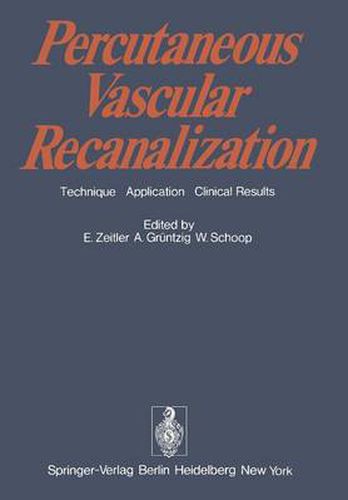Readings Newsletter
Become a Readings Member to make your shopping experience even easier.
Sign in or sign up for free!
You’re not far away from qualifying for FREE standard shipping within Australia
You’ve qualified for FREE standard shipping within Australia
The cart is loading…






This title is printed to order. This book may have been self-published. If so, we cannot guarantee the quality of the content. In the main most books will have gone through the editing process however some may not. We therefore suggest that you be aware of this before ordering this book. If in doubt check either the author or publisher’s details as we are unable to accept any returns unless they are faulty. Please contact us if you have any questions.
The number of patients with occlusive peripheral vascular disease of the lower ex- tremities is still growing as rapidly as the number of patients with coronary heart disease and cerebrovascular disease. Due to the increase in average life expectancy during the last few decades, more patients now need surgical vascular reconstruc- tion. This actually means a demand for more centers specializing in vascular surgery and equipped with intensive care facilities, since the number of patients with cardio- vascular and bronchopulmonary complications is increasing as well. In addition, the number of patients needing repeated vascular surgery has been growing. Therefore, the search for simple procedures to recanalize the arterial lumen which could be performed under local anesthesia is no surprise. Unfortunately peripheral vascular disease is still frequently treated by amputations. In 1967, the fIrst report in German on percutaneous recanalization of arteries with thrombotic occlusions and stenoses appeared in Rontgenfortschritte. The meth- od described in this report had been published by Dotter and Judkins in 1964. Today, 10 years after their report, more data have been systematically collected on this method in Europe than in the United States, where it was developed. Possibly an explanation of this state of affairs is that nonsurgical treatment is favored more in Europe than in the United States. The scientifIcally based angiology established by Ratschow served as the foun- dation for the development of diagnostic work-up and therapy in other directions beyond the questions of operability and surgical results.
$9.00 standard shipping within Australia
FREE standard shipping within Australia for orders over $100.00
Express & International shipping calculated at checkout
This title is printed to order. This book may have been self-published. If so, we cannot guarantee the quality of the content. In the main most books will have gone through the editing process however some may not. We therefore suggest that you be aware of this before ordering this book. If in doubt check either the author or publisher’s details as we are unable to accept any returns unless they are faulty. Please contact us if you have any questions.
The number of patients with occlusive peripheral vascular disease of the lower ex- tremities is still growing as rapidly as the number of patients with coronary heart disease and cerebrovascular disease. Due to the increase in average life expectancy during the last few decades, more patients now need surgical vascular reconstruc- tion. This actually means a demand for more centers specializing in vascular surgery and equipped with intensive care facilities, since the number of patients with cardio- vascular and bronchopulmonary complications is increasing as well. In addition, the number of patients needing repeated vascular surgery has been growing. Therefore, the search for simple procedures to recanalize the arterial lumen which could be performed under local anesthesia is no surprise. Unfortunately peripheral vascular disease is still frequently treated by amputations. In 1967, the fIrst report in German on percutaneous recanalization of arteries with thrombotic occlusions and stenoses appeared in Rontgenfortschritte. The meth- od described in this report had been published by Dotter and Judkins in 1964. Today, 10 years after their report, more data have been systematically collected on this method in Europe than in the United States, where it was developed. Possibly an explanation of this state of affairs is that nonsurgical treatment is favored more in Europe than in the United States. The scientifIcally based angiology established by Ratschow served as the foun- dation for the development of diagnostic work-up and therapy in other directions beyond the questions of operability and surgical results.